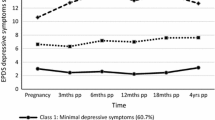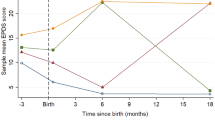Abstract
The present study identifies trajectories of maternal depressive symptoms in Korean contexts and explores their associations with children’s behavioral problems at four years of age. Using the Panel Study of Korean Children, depressive symptoms of 1,964 mothers were collected at five time points (right after childbirth at hospitals, one month postpartum, four months postpartum, 24 months postpartum, and 48 months postpartum). These data were analyzed using latent class growth analysis. Korean mothers’ depressive symptoms from childbirth to 48 months postpartum were best described by five trajectories: No Symptoms (30.8 %), Low Symptoms (46.8 %), Increasing Symptoms (9.2 %), Persistent Moderate Symptoms (8.8 %), and High Symptoms (4.3 %). In addition, trajectories of depressive symptoms of Korean mothers were found to have meaningful associations with their children’s behavioral problems at four years of age. However, the complex results of the present study provided no clear answers regarding how chronicity, severity, and timing of maternal depressive symptoms associate with young children’s behavioral problems.

Similar content being viewed by others
References
Achenbach, T. M., & Rescorla, L. A. (2001). Manual for the ASEBA school-Age forms & profiles. Burlington: University of Vermont, Research Center for Children, Youth, & Families.
American Psychiatric Association. (2013). Diagnostic and statistical manual of mental disorders (DSM-5®). Arlington: American Psychiatric Publishing.
Bahk, J., Yun, S. C., Kim, Y. M., & Khang, Y. H. (2015). Changes in the relationship between socioeconomic position and maternal depressive symptoms: results from the panel study on Korean children (PSKC). Maternal and Child Health Journal, 19(9), 2057–2065.
Belfield, C. R., Nores, M., Barnett, S., & Schweinhart, L. (2006). The high/scope Perry preschool program cost–benefit analysis using data from the age-40 follow up. Journal of Human Resources, 41(1), 162–190.
Brennan, P. A., Hammen, C., Andersen, M. J., Bor, W., Najman, J. M., & Williams, G. M. (2000). Chronicity, severity, and timing of maternal depressive symptoms: relationships with child outcomes at age 5. Developmental Psychology, 36(6), 759–766.
Brennan, P. A., Hammen, C., Katz, A. R., & Le Brocque, R. M. (2002). Maternal depression, paternal psychopathology, and adolescent diagnostic outcomes. Journal of Consulting and Clinical Psychology, 70(5), 1075.
Buss, A. H., & Plomin, R. (1984). Temperament: early develo** personality traits. Hillsdale: Erlbaum.
Butler, E. A., Lee, T. L., & Gross, J. J. (2007). Emotion regulation and culture: Are the social consequences of emotion suppression culture-specific? Emotion, 7(1), 30.
Campbell, S. B., Matestic, P., von Stauffenberg, C., Mohan, R., & Kirchner, T. (2007). Trajectories of maternal depressive symptoms, maternal sensitivity, and children's functioning at school entry. Developmental Psychology, 43(5), 1202–1215.
Carter, A. S., Garrity-Rokous, F. E., Chazan-Cohen, R., Little, C., & Briggs-Gowan, M. J. (2001). Maternal depression and comorbidity: predicting early parenting, attachment security, and toddler social-emotional problems and competencies. Journal of the American Academy of Child and Adolescent Psychiatry, 40(1), 18–26.
Cents, R. A. M., Diamantopoulou, S., Hudziak, J. J., Jaddoe, V. W. V., Hofman, A., Verhulst, F. C.,… & Tiemeier, H. (2013). Trajectories of maternal depressive symptoms predict child problem behaviour: The Generation R study. Psychological Medicine, 43, 13–25.
Claessens, A., Engel, M., & Curran, F. C. (2015). The effects of maternal depression on child outcomes during the first years of formal schooling. Early Childhood Research Quarterly, 32, 80–93.
Dannemiller, J. L. (1999). Chronicity of maternal depressive symptoms, maternal sensitivity, and child functioning at 36 months. Developmental Psychology, 35(5), 1297–1310.
Frick, P. J., & Morris, A. S. (2004). Temperament and developmental pathways to conduct problems. Journal of Clinical Child and Adolescent Psychology, 33(1), 54–68.
Goodman, S. H., & Gotlib, I. H. (1999). Risk for psychopathology in the children of depressed mothers: a developmental model for understanding mechanisms of transmission. Psychological Review, 106(3), 458.
Goodman, S. H., Rouse, M. H., Connell, A. M., Broth, M. R., Hall, C. M., & Heyward, D. (2011). Maternal depression and child psychopathology: a meta-analytic review. Clinical Child and Family Psychology Review, 14(1), 1–27.
Health Insurance Review and Assessment Service (2016) 질병행위통계 [Statistics for diseases and treatments]. Seoul, Korea: Health Insurance Review and Assessment Service. Retrieved from http://www.hira.or.kr/rd/dissdic/infoSickList.do?pgmid=HIRAA020044020100
Hinshaw, S. P., Han, S. S., Erhardt, D., & Huber, A. (1992). Internalizing and externalizing behavior problems in preschool children: correspondence among parent and teacher ratings and behavior observations. Journal of Clinical Child Psychology, 21(2), 143–150.
Hoe, M. (2014). Exploring latent trajectory classes of change in depression measured using CES-D. Korean Journal of Social Welfare, 66(1), 307–331.
Jeon, H. J., Walker, R. S., Inamori, A., Hong, J. P., Cho, M. J., Baer, L.,… & Mischoulon, D. (2014). Differences in depressive symptoms between Korean and American outpatients with major depressive disorder. International Clinical Psychopharmacology, 29(3), 150–156.
Jung, T., & Wickrama, K. A. S. (2008). An introduction to latent class growth analysis and growth mixture modeling. Social and Personality Psychology Compass, 2(1), 302–317.
Kessler, R. C., Barker, P. R., Colpe, L. J., Epstein, J. F., Gfroerer, J. C., Hiripi, E.,… & Zaslavsky, A. M. (2003). Screening for serious mental illness in the general population. Archives of General Psychiatry, 60(2), 184–189.
Kim, J. M., & Kim, J. (2015). The effect of mothers’ depression on preschool children’s development : focusing on the mediation of home environment. Korean Journal of Human Ecology, 24(2), 159–170.
Kim, Y. A., Lee, J., Moon, S. J., Kim, Y. J., & Oh, K. J. (2009). Standardization study for the Korean version of the child behavior checklist for ages 1.5-5. The Korean Journal of Clinical Psychology, 28(1), 117–136.
Korea Institute of Childcare and Education (2008) 한국아동패널 (2008) 1차년도 도구 프로파일 [Instrument profile for Panel Study of Korean Children 2008]. Seoul, Korea: Korea Institute of Childcare and Education. Retrieved from http://panel.kicce.re.kr/kor/publication/01_02.jsp?mode=view&idx=7003&startPage=20&listNo=1&code=paneltoolsprofiles&search_item=&search_order=&order_list=10&list_scale=10&view_level=0
Korean Statistical Information Service (2016) 2006-2011 정신질환실태조사 [2006-2011 National Survey on mental diseases]. Seoul, Korea: Korean Statistical Information Service. Retrieved from http://kosis.kr/statisticsList/statisticsList_01List.jsp?vwcd=MT_ZTITLE&parentId=D#SubCont
Lee, Y., & Kim, G. (2015). The trajectories and predictors of maternal post natal depressive symptoms in a high risk group, based on latent growth modeling. Korean Journal of Child Studies, 36(3), 77–92.
Lim, J.B., Lee, Y.J., & Kim, S. (2014.) 한국아동패널 탈락자 특성 분석 [Determinants of attrition in Panel Study of Korean Children]. In Y. G. Choi (Ed.), 한국아동패널 2014 심층분석 연구 [In-depth analyses of 2014 Panel Study of Korean Children] (pp. 77–92). Seoul, Korea: Korea Institute of Childcare and Education. Retrieved from http://panel.kicce.re.kr/kor/inquiry/03.jsp?mode=view&idx=16947&startPage=0&listNo=15&code=panelreport&search_item=&search_order=&order_list=10&list_scale=10&view_level=0
Matijasevich, A., Murray, J., Cooper, P. J., Anselmi, L., Barros, A. J., Barros, F. C., & Santos, I. S. (2015). Trajectories of maternal depression and offspring psychopathology at 6 years: 2004 Pelotas cohort study. Journal of Affective Disorders, 174, 424–431.
McCubbin, H. I., Patterson, J., & Wilson, L. (1982). Family inventory of life events scale (FILE). St. Paul: Univ. of Minnesota, Department of Family Social Science.
McGinnis, E., Bocknek, E., Beeghly, M., Rosenblum, K. L., & Muzik, M. (2015). Does child sex moderate vulnerability to postpartum risk among infants of mothers at risk for psychopathology? Infancy, 20(1), 42–69.
McGrath, J. M., Records, K., & Rice, M. (2008). Maternal depression and infant temperament characteristics. Infant Behavior and Development, 31(1), 71–80.
Mezulis, A. H., Hyde, J. S., & Clark, R. (2004). Father involvement moderates the effect of maternal depression during a child's infancy on child behavior problems in kindergarten. Journal of Family Psychology, 18(4), 575.
Muthén, L. K., & Muthén, B. O. (1998–2012). Mplus users’guide seventh edition. Los Angeles, CA: Muthén & Muthén.
Muthén, B., & Muthén, L. K. (2000). Integrating person‐centered and variable‐centered analyses: growth mixture modeling with latent trajectory classes. Alcoholism: Clinical and Experimental Research, 24(6), 882–891.
Park, S. Y., & Bernstein, K. S. (2008). Depression and Korean American immigrants. Archives of Psychiatric Nursing, 22(1), 12–19.
Van Der Knaap, L. J., Riese, H., Hudziak, J. J., Verbiest, M. M., Verhulst, F. C., Oldehinkel, A. J., & van Oort, F. V. (2015). Adverse life events and allele-specific methylation of the serotonin transporter gene (SLC6A4) in adolescents: the TRAILS study. Psychosomatic Medicine, 77(3), 246–255.
Van Der Waerden, J., Galéra, C., Larroque, B., Saurel-Cubizolles, M. J., Sutter-Dallay, A. L., Melchior, M., & EDEN Mother–Child Cohort Study Group. (2015). Maternal depression trajectories and children's behavior at age 5 years. The Journal of Pediatrics, 166(6), 1440–1448.
Author information
Authors and Affiliations
Corresponding author
Rights and permissions
About this article
Cite this article
Kim, Y.H. Trajectories of Maternal Depressive Symptoms and Behavioral Problems of Children at Four Years of Age: Evidence from the Panel Study of Korean Children. Child Ind Res 10, 1061–1078 (2017). https://doi.org/10.1007/s12187-016-9417-8
Accepted:
Published:
Issue Date:
DOI: https://doi.org/10.1007/s12187-016-9417-8




